|
Trefonen 18th August 2012
In the hope that the excursions around Llynclys for Autumn Ladies Tresses failing was due to being a week or so too early, we visit another site; a couple of fields between Oswestry and Welshpool. The NBN database had recent records for ALTs there and a footpath runs right through the middle - perfect. But yet again, we have no luck. Perhaps sheep find the flowers tasty!
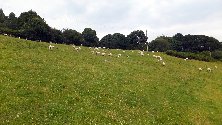
Marford Quarry 9th August 2012
Buoyed by the discovery of the Dune and Green Flowered Helleborines at Alyn Waters its off to Marford Quarry a couple of miles away. More internet research has revealed that E. phyllanthes has recent records from here and these records are quite specific as to where they grow. Looks good to me! The quarry is an old sand and gravel excavation; I think it was employed during the construction of the Mersey Tunnels. Like Alyn Waters, I had visited it years ago, but it has changed significantly especially at the Gresford end due to tree planting. In between I had been there briefly after a mention in the local paper referred to Bee Orchids being found there. This brief visit a while ago found none, but in the main quarry an area of perhaps 15 metres square had been fenced off with netting. Perhaps that was protecting the orchids, from rabbits or collectors, I thought, but nothing could be seen peering over the fence.
Anyway, we know where we are going and following the paths we find a small colony of E. phyllanthes exactly where we hope they would be! In deciduous woodland close to the Chester to Shrewsbury railway track. Plenty of photos taken as I know from experience that my camera is just as likely to focus on the background as the flowers, even in extreme close-up. And the light in woodland is not that great. Onwards to the second location, a bit further in and half way up a slope. More photos. Looking at the photographs I can see that both sites have what seems to be E. phyllanthes pendula. The epichile is heart shaped and the hypochile is roughly the same size.
A successful day, and I must visit again.
  
Alyn Waters Country Park 9th Aug 2012
I have been inspired by all the helleborines found at Formby and being a collector have been reading up on the Epipactis genus for information about the different populations of the Dune Helleborines, E. sancta, youngiana, the Tyne variants and all the oddities that have cropped up around Kenfig for this genus. What do I find? A country park virtually on my doorstep has perhaps the biggest colony of E. dunensis in Britain, if not the world! A population estimated variously at 1,000, 5,000, or 10,000 plants. And their identity has been confirmed officially. For many years these were assumed to be Broad-leaved Helleborines, until an enthusiast had a close look in 2010. Not only that, but E. phyllanthes in some numbers also live here. I have been to this place before but perhaps 15-20 years ago when I noted only Common Spotteds and Common Twayblades and not very many of each either. Too few and too common to warrant a return visit. Alas I find that I have missed the ranger`s orchid field walk around the park this year or I might have found the best places to go straight to, but I surely I cannot fail to find a 10000+ colony. A friend has also informed me of Bee Orchids there too, but those must have finished flowering by now.
So what have we found? Yes there were many many Dune Helleborines, and a fair few Green Flowered Helleborines to boot. Both E. phyllanthes pendula and E. phyllanthes degenera seem to be present, the former more commonly. The latter are represented by a few plants that have swollen ovaries while the flowers have not seemed to open. Perhaps I should have carefully opened up one of the flowers to have a better look at the structure before claiming the variety. These orchids grew all under the birch trees on the Llay side of the country park. [Note: Alyn Waters is in two parts separated by the River Alyn, a lane and some fields, and accessible from either the Gwersyllt side and the Llay side] What is more, within the trees is an enormous colony of Common Twayblades. Huge plants growing so thick its hard to walk there without treading on them. A few Fragrant Orchids were present but were way past their best and any attempt to decide which exact species would be impossible for now; next year perhaps.
  
The Dune Helleborines
   
Three views of E. phyllanthes pendula and one of E. phyllanthes degenera
 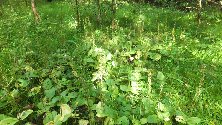
The Common Twayblades, close up and as a grove
So where has this colony come from? E. dunensis has formerly been reported from western British coastal areas - Anglesey, Lancashire, and Cumbria. Then we get similar plants of uncertain taxonomy from NE England and Central Scotland living more inland. This area here at the turn of the 20th century was farmland, but after WWII it was used for sand and gravel extraction by McAlpines. This ceased in the 1980s and the land returned to nature. I visited soon after it was opened as a country park and noted just a single Common Spotted and single Common Twayblade. The general opinion is that wind blow seed has found its way here, probably from Newborough, Anglesey. Possible, but that raises a potential for other sites at suitable locations between and beyond. As some of the pioneer plants at AWCP are estimated to be 20 years old this colonisation happened soon after re-landscaping.
Llanymynech Rocks 9th August 2012
Second visit of the year to the area, but this time specifically for Autumn Ladies Tresses, This time the hunt is focussed on the old limestone quarrying area above Llanymynech which can be reached via the old tramway incline which passes under the A483 just north of the village. You can still see the railtrack in place at several points within the site and I was surprised to discover that there was a tunnel for the track under the A483 - a road I have been down many many times. There are several quite specific places in the databases for ALT locations in the immediate area, but the quarry seemed to be the most likely. Depite quite an extensive search, especially in the more cropped grass, we find no ALTs. But its not all doom and gloom. There are some Pyramidal Orchids in a range of shades of purple, and some Fragrants; I think these are Heath Fragrants, but most are so far past their best it is hard to tell. Whatever, its a nice find.
A field just off the A483 and the verge on a road leading up the hill at Pant were also ALT potential sites but both yielded nothing. Perhaps 2013 was one of the years where these elusive plants are rather scarce - or were we just there at the wrong week? They are very hard to find even in flower. Another field between Pant and Llynclys is a possibility for future searches.
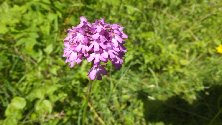 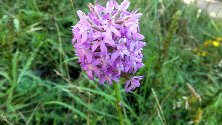 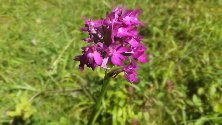
Three ‘flavours’ of Pyramidal Orchids
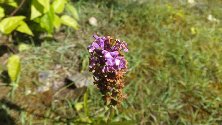 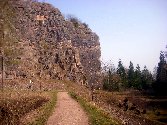
The Fragrant Orchid and a view of the quarry
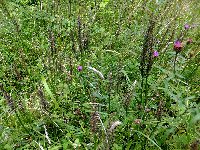
The Common Spotteds must have
put on a good display a while earlier.
Lancashire Coast 8th August 2012
Having visited one site for the Dune Helleborine a bit early this year another opportunity comes up. And there is a whole stretch of dunes and woodlands along this bit of coast with the potential for orchids - indeed their existence is well documented. So a bit further north this time and a walk along the perimeter of, and through the woods, seemed a good idea - especially as the first Dune Helleborine was found within the first 50 yards. You know how you spend ages photographing the first few you find, no matter how difficult or how poor the specimens are? Well this was one of those days. Within a mile or two many, many others were found, always within the edges of the woodland, and often in full flower. But you have to keep alert, as in between there are smaller examples of E. phyllanthes, often single specimens. A trip across the dunes though, revealed nothing to add to the tally.
A trip to the original site under pines showed that the plants closest to the road to the dunes and the beach at Formby had largely disappeared, even though they were there in 2009. However the considerable spread previously found under the pines further back from the road were still looking good, though many of the flower stalks had been picked.
   
The Dune Helleborines
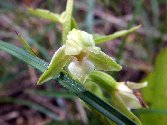  
The Green Flowered Helleborines
|
